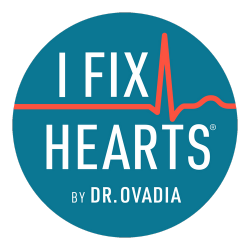High blood pressure is a sign that your heart is working too hard and is under strain. If heart disease prevention is a priority for you, then you’ll want to work on lowering your blood pressure to a healthy range.
That can be easier said than done though, because high blood pressure doesn’t always result in symptoms. In fact, around 20% of the 100 million Americans with high blood pressure are completely unaware. Unlike many other health conditions, the only way to find out if your blood pressure is normal or high is to measure it.
In this article, I’m going to share with you:
- What blood pressure numbers mean so you can check yours
- Reasons to maintain a healthy range
- How to lower your blood pressure
Understanding healthy blood pressure
As blood travels through the arteries, it puts pressure against the artery walls. This is what the term “blood pressure” refers to, and it’s made up of two numbers:
- The first number measures the pressure when your heart beats, and this is called systolic blood pressure
- The second number measures the pressure between heart beats, and this is called diastolic blood pressure
When you have your blood pressure measured, you’ll see or hear it as something like 130 over 90, or 130/90. The 130 is the systolic pressure and the 90 is the diastolic pressure.
The CDC puts a normal blood pressure as up to 120/80, with 120-139/80-89 as “at risk” or prehypertension, and 140/90 or above as having high blood pressure, or hypertension.
Why you want normal range blood pressure
If left alone, high blood pressure can damage your blood vessels and lead to cardiovascular disease and the following serious conditions:
- Heart attack
- Stroke
- Heart failure
- Kidney disease or failure
- Vision loss
- Sexual dysfunction
- Angina
- Peripheral artery disease
As you can see, maintaining normal range blood pressure is an important part of improving heart health.
However, the dangers aren’t limited to high blood pressure – it’s also possible to have low blood pressure (hypotension). A systolic reading of 90 and diastolic reading of 60 are considered low. Sometimes there’s a clear reason for low blood pressure, such as dehydration, pregnancy, or shock. Other times, it can be a warning of an underlying medical condition or malnutrition.
Low blood pressure can cause symptoms including dizziness, fainting and blurred vision. If you have it, it’s important to find out why and to get into the healthy range.
If your blood pressure is higher than 120/80, it’s time to review your lifestyle to improve your cardiovascular health – don’t be complacent and think that if you eventually suffer from a cardiovascular disease you’ll just get treatment. Heart disease prevention is always better than cure.
How to lower your blood pressure
In many instances, heart disease prevention comes from you. I’ve written before about how simple changes to your lifestyle will lower your blood pressure and improve your cardiovascular health. Best of all, these changes are simple and can be incorporated into your daily routine. If you’re taking steps to improve cardiovascular health, you’ll likely notice improvements in your blood pressure too. These steps include:
- Eating a metabolically healthy diet based on whole, real food
- Maintaining a healthy weight and reversing obesity
- Consuming alcohol only in moderation
- Avoiding tobacco products
- Exercise, particularly resistance and cardiovascular training
Each of the above is important, but the single most important thing to remember when trying to improve cardiovascular health is that you are what you eat.
Everywhere you look we’re surrounded by awful food choices – colorful boxes of sugar and seed oils. On top of that, we’re bombarded with misinformation about what’s healthy, so in many instances people simply don’t realize they’re eating the wrong things.
Fortunately, eating a heart healthy diet is simple. Eat what grows in the ground or what eats things that grow in the ground. It really is that simple. Eating whole unprocessed foods is the primary mechanism for improving heart (and overall) health – even if you exercise a lot, it’s impossible to out train a bad diet.
Getting on top of your blood pressure
Unless you’ve been told otherwise by your doctor, high blood pressure is a good indicator that something is wrong in your body. In some cases, it’s the symptom of a long-term illness that requires its own treatment. In other cases, it’s a warning to make different choices in your daily life and improve your cardiovascular health.
Having your blood pressure checked is quick and easy, and knowing if you suffer from high blood pressure is the first step in knowing if you need to make a change.
Blood pressure has a direct relationship with metabolic health, too. Improving one will improve the other.
To find out how metabolically healthy you are currently, and what areas you may need to improve, take my free metabolic health quiz.
